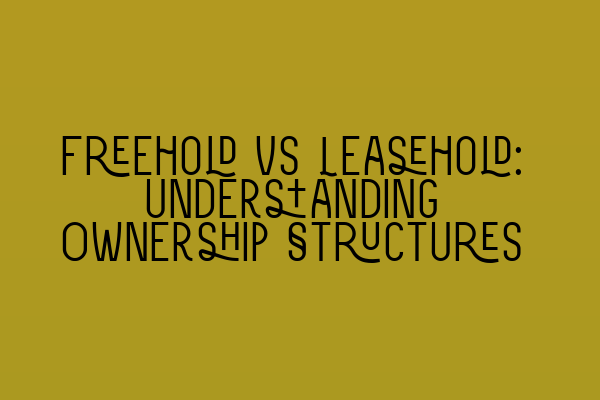[Blog Post]
Freehold vs Leasehold: Understanding Ownership Structures
When it comes to property ownership, understanding the differences between freehold and leasehold is crucial. Whether you’re a prospective buyer, a property investor, or even a homeowner, it’s essential to know the key features and implications of each ownership structure. In this blog post, we’ll explore the differences between freehold and leasehold properties, empowering you with the knowledge to make informed decisions.
1. Defining Freehold and Leasehold:
– Freehold: In simple terms, freehold refers to absolute ownership of a property and the land it stands on. When you own a freehold property, you have full control and possession for an indefinite period. Freehold ownership grants you the freedom to make decisions about the property without any limitations, subject only to local planning and zoning regulations.
– Leasehold: Unlike freehold, leasehold ownership involves owning the property for a fixed period of time, typically between 99 to 999 years. In leasehold ownership, you have the right to occupy and use the property within the terms outlined in the lease agreement. However, the actual ownership of the land remains with the freeholder, granting them certain rights and control over the property.
2. Key Features of Freehold Ownership:
– Absolute ownership: As a freeholder, you have complete control over the property, including both the land and any buildings on it. You can use, modify, or sell the property as you see fit, within the boundaries of local regulations.
– No ground rent: Unlike leasehold properties, freehold ownership waives the payment of ground rent to a landlord or freeholder. This makes it more cost-effective in the long run and can be an attractive option for those seeking complete ownership.
– More control over maintenance: As a freeholder, you are solely responsible for maintaining and repairing the property. While this means more expenses, it also gives you the freedom to choose tradespeople and determine the level and quality of maintenance.
– Greater autonomy: Freehold ownership allows you to make decisions regarding property modifications and enhancements without needing permission from a landlord or freeholder. This level of autonomy can be advantageous for those who wish to customize their living space or investment property.
3. Key Features of Leasehold Ownership:
– Finite ownership: With leasehold ownership, you have the right to occupy and use the property for a predetermined period of time. Once the lease expires, ownership reverts back to the freeholder unless a lease extension or renewal is agreed upon.
– Ground rent and service charges: As a leaseholder, you are typically required to pay ground rent and potentially service charges to the freeholder or landlord. These charges contribute to the maintenance, insurance, and management of the property.
– Restrictions and permissions: Leasehold ownership often comes with certain restrictions and obligations. For example, you may need to seek permission for alterations, subletting, or even keeping pets. It’s important to carefully review the terms and conditions of the lease agreement to avoid any potential conflicts.
– Shared ownership: Leasehold properties can also be part of shared ownership schemes, where you purchase a partial share of the property, usually from a housing association or developer. In such cases, there may be additional rules and regulations that govern the shared ownership arrangement.
4. Choosing the Right Ownership Structure:
The choice between freehold and leasehold ownership depends on your personal circumstances, financial capability, and long-term goals. Consider the following factors when making your decision:
– Property type and location: Certain types of properties, such as apartments or properties in developments, are more commonly leasehold. Understanding the local property market and its prevalent ownership structures can help guide your decision.
– Longevity: If you’re planning to own the property for a significant period or envision passing it on to future generations, freehold ownership ensures continuity and minimizes potential complications.
– Budget and cost considerations: Leasehold properties often come with additional costs such as ground rent, service charges, and potential lease extension fees. Evaluate your financial capability and consider the long-term costs associated with each ownership option.
– Future flexibility: Freehold ownership provides more freedom to adapt the property to your changing needs. If customization and alterations are important to you, freehold ownership may be the better choice.
– Legal implications: It’s crucial to consult a property law solicitor to fully understand the legal implications and obligations associated with either ownership structure, especially before signing any contracts.
In conclusion, understanding the distinctions between freehold and leasehold ownership structures is essential for making informed decisions in the property world. Both ownership structures offer unique benefits and considerations, and it is vital to weigh them against your individual circumstances and goals. By doing so, you’ll be equipped to navigate the property market intelligently and confidently.
At SQE Property Law & Land Law, our team of expert solicitors specialize in property law and can assist you in making informed decisions regarding freehold and leasehold properties. Contact us today for professional advice tailored to your specific needs.
[End of Blog Post]
